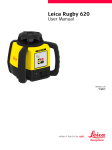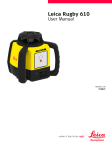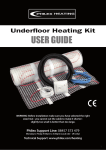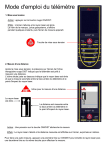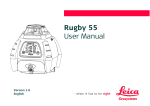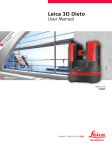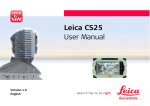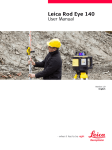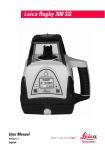Download Leica Rugby 640 User Manual - WU Technologies WU Technologies
Transcript
Leica Rugby 640 User Manual Version 1.0 English Introduction Purchase Congratulations on the purchase of a Leica Rotating Laser product. This manual contains important safety directions as well as instructions for setting up the product and operating it. Refer to "1 Safety Directions" for further information. Read carefully through the User Manual before you switch on the product. Product identification The type and serial number of your product are indicated on the type plate. Enter the type and serial number in your manual and always refer to this information when you need to contact your agency or Leica Geosystems authorised service workshop. Type: _______________ Serial No.: _______________ Validity of this manual This manual applies to the Rugby 640 lasers. Differences between the models are marked and described. Available documentation Name Description/Format Rugby 640 Quick Guide Provides an overview of the product. Intended as a quick reference guide. Rugby 640 User All instructions required in order to operate the product Manual to a basic level are contained in the User Manual. Provides an overview of the product together with technical data and safety directions. Refer to the following resources for all Rugby 640 documentation/software: • the Leica Rugby CD • https://myworld.leica-geosystems.com Rugby 640, Introduction 2 myWorld@Leica Geosystems (https://myworld.leica-geosystems.com) offers a wide range of services, information and training material. With direct access to myWorld, you are able to access all relevant services whenever it is convenient for you, 24 hours a day, 7 days per week. This increases your efficiency and keeps you and your equipment instantly updated with the latest information from Leica Geosystems. Service Description myProducts Simply add all Leica Geosystems products that you and your company own. View detailed information on your products, buy additional options or Customer Care Packages (CCPs), update your products with the latest software and keep up-to-date with the latest documentation. myService View the service history of your products in Leica Geosystems Service Centers and detailed information on the services performed on your products. For your products that are currently in Leica Geosystems Service Centers view the current service status and the expected end date of service. mySupport Create new support requests for your products that will be answered by your local Leica Geosystems Support Team. View the complete history of your Support and view detailed information on each request in case you want to refer to previous support requests. myTraining Enhance your product knowledge with the Leica Geosystems Campus - Information, Knowledge, Training. Study the latest online training material or download training material on your products. Keep upto-date with the latest News on your products and register for Seminars or Courses in your country. Rugby 640, Introduction 3 Table of Contents In this manual Chapter 1 Safety Directions 1.1 1.2 1.3 1.4 1.5 1.6 1.7 1.8 2 Setting Forms Checking Grades Manual Grades Batter Boards Facades Suspended Ceilings Layout More Applications Batteries 6.1 6.2 7 Rod Eye 140, Classic Receiver Menu - Rod Eye 140, Classic Receiver Rod Eye Basic Receiver Applications 5.1 5.2 5.3 5.4 5.5 5.6 5.7 5.8 6 Buttons LED Indicators Turning on and off the Rugby Automatic Mode Manual Mode Elevation Alert (H.I.) Function Receivers 4.1 4.2 4.3 5 System Components Rugby Laser Components Case Components Setup RC400 Remote Control 2.5.1 Pairing the Rugby 640 with the RC400 Remote Control Operation 3.1 3.2 3.3 3.4 3.5 3.6 4 General Definition of Use Limits of Use Responsibilities Hazards of Use Laser Classification 1.6.1 General 1.6.2 Rugby 640 Electromagnetic Compatibility EMC FCC Statement, Applicable in U.S. Description of the System 2.1 2.2 2.3 2.4 2.5 3 Page Operating Principles Battery for Rugby Accuracy Adjustment 7.1 7.2 Rugby 640, Table of Contents Checking the Level Accuracy Adjusting the Level Accuracy 6 6 7 7 7 8 10 10 10 11 12 14 14 14 15 16 17 18 19 19 19 20 20 21 22 23 23 24 25 27 27 28 29 30 31 33 34 35 36 36 36 39 39 40 4 8 9 Troubleshooting 42 Care and Transport 44 44 44 45 9.1 9.2 9.3 10 Transport Storage Cleaning and Drying Technical Data 10.1 10.2 Conformity to National Regulations General Technical Data of the Laser 10.2.1 RC400 Remote Control 46 46 46 47 11 Lifetime Manufacturer’s Warranty 48 12 Accessories 49 Index Rugby 640, Table of Contents 51 5 1 Safety Directions 1.1 General Description The following directions enable the person responsible for the product, and the person who actually uses the equipment, to anticipate and avoid operational hazards. The person responsible for the product must ensure that all users understand these directions and adhere to them. About Warning Messages Warning messages are an essential part of the safety concept of the instrument. They appear wherever hazards or hazardous situations can occur. Warning messages... • make the user alert about direct and indirect hazards concerning the use of the product. • contain general rules of behaviour. For the users‘ safety, all safety instructions and safety messages shall be strictly observed and followed! Therefore, the manual must always be available to all persons performing any tasks described herein. DANGER, WARNING, CAUTION and NOTICE are standardized signal words for identifying levels of hazards and risks related to personal injury and property damage. For your safety it is important to read and fully understand the table below with the different signal words and their definitions! Supplementary safety information symbols may be placed within a warning message as well as supplementary text. Type DANGER WARNING CAUTION NOTICE Rugby 640, Safety Directions Description Indicates an imminently hazardous situation which, if not avoided, will result in death or serious injury. Indicates a potentially hazardous situation or an unintended use which, if not avoided, could result in death or serious injury. Indicates a potentially hazardous situation or an unintended use which, if not avoided, may result in minor or moderate injury. Indicates a potentially hazardous situation or an unintended use which, if not avoided, may result in appreciable material, financial and environmental damage. Important paragraphs which must be adhered to in practice as they enable the product to be used in a technically correct and efficient manner. 6 1.2 Definition of Use Intended use • The product casts a horizontal laser plane or a laser beam for the purpose of alignment. • The laser beam can be detected by means of a laser detector. • Remote control of product. • Data communication with external appliances. Reasonably foreseeable misuse • • • • • • • • • • • • Use of the product without instruction. Use outside of the intended use and limits. Disabling safety systems. Removal of hazard notices. Opening the product using tools, for example screwdriver, unless this is permitted for certain functions. Modification or conversion of the product. Use after misappropriation. Use of products with recognisable damages or defects. Use with accessories from other manufacturers without the prior explicit approval of Leica Geosystems. Inadequate safeguards at the working site. Deliberate dazzling of third parties. Controlling of machines, moving objects or similar monitoring application without additional control- and safety installations. 1.3 Limits of Use Environment Suitable for use in an atmosphere appropriate for permanent human habitation: not suitable for use in aggressive or explosive environments. DANGER Local safety authorities and safety experts must be contacted before working in hazardous areas, or close to electrical installations or similar situations by the person in charge of the product. 1.4 Responsibilities Manufacturer of the product Leica Geosystems AG, CH-9435 Heerbrugg, hereinafter referred to as Leica Geosystems, is responsible for supplying the product, including the user manual and original accessories, in a safe condition. Person responsible for the product The person responsible for the product has the following duties: • To understand the safety instructions on the product and the instructions in the user manual. • To ensure that it is used in accordance with the instructions. • To be familiar with local regulations relating to safety and accident prevention. • To inform Leica Geosystems immediately if the product and the application becomes unsafe. • To ensure that the national laws, regulations and conditions for the operation of e.g. radio transmitters or lasers are respected. Rugby 640, Safety Directions 7 1.5 CAUTION DANGER NOTICE WARNING WARNING CAUTION CAUTION Hazards of Use Watch out for erroneous measurement results if the product has been dropped or has been misused, modified, stored for long periods or transported. Precautions: Periodically carry out test measurements and perform the field adjustments indicated in the user manual, particularly after the product has been subjected to abnormal use and before and after important measurements. Because of the risk of electrocution, it is dangerous to use poles and extensions in the vicinity of electrical installations such as power cables or electrical railways. Precautions: Keep at a safe distance from electrical installations. If it is essential to work in this environment, first contact the safety authorities responsible for the electrical installations and follow their instructions. With the remote control of products, it is possible that extraneous targets will be picked out and measured. Precautions: When measuring in remote control mode, always check your results for plausibility. If the product is used with accessories, for example masts, staffs, poles, you may increase the risk of being struck by lightning. Precautions: Do not use the product in a thunderstorm. Inadequate securing of the working site can lead to dangerous situations, for example in traffic, on building sites, and at industrial installations. Precautions: Always ensure that the working site is adequately secured. Adhere to the regulations governing safety and accident prevention and road traffic. If the accessories used with the product are not properly secured and the product is subjected to mechanical shock, for example blows or falling, the product may be damaged or people can sustain injury. Precautions: When setting-up the product, make sure that the accessories are correctly adapted, fitted, secured, and locked in position. Avoid subjecting the product to mechanical stress. During the transport, shipping or disposal of batteries it is possible for inappropriate mechanical influences to constitute a fire hazard. Precautions: Before shipping the product or disposing of it, discharge the batteries by running the product until they are flat. When transporting or shipping batteries, the person in charge of the product must ensure that the applicable national and international rules and regulations are observed. Before transportation or shipping contact your local passenger or freight transport company. Rugby 640, Safety Directions 8 WARNING WARNING WARNING During dynamic applications, for example stakeout procedures there is a danger of accidents occurring if the user does not pay attention to the environmental conditions around, for example obstacles, excavations or traffic. Precautions: The person responsible for the product must make all users fully aware of the existing dangers. If you open the product, either of the following actions may cause you to receive an electric shock. • Touching live components • Using the product after incorrect attempts were made to carry out repairs Precautions: Do not open the product. Only Leica Geosystems authorised service workshops are entitled to repair these products. If the product is improperly disposed of, the following can happen: • If polymer parts are burnt, poisonous gases are produced which may impair health. • If batteries are damaged or are heated strongly, they can explode and cause poisoning, burning, corrosion or environmental contamination. • By disposing of the product irresponsibly you may enable unauthorised persons to use it in contravention of the regulations, exposing themselves and third parties to the risk of severe injury and rendering the environment liable to contamination. Precautions: The product must not be disposed with household waste. Dispose of the product appropriately in accordance with the national regulations in force in your country. Always prevent access to the product by unauthorised personnel. Product-specific treatment and waste management information can be downloaded from the Leica Geosystems home page at http://www.leica-geosystems.com/treatment or received from your Leica Geosystems dealer. WARNING WARNING WARNING Only Leica Geosystems authorised service workshops are entitled to repair these products. High mechanical stress, high ambient temperatures or immersion into fluids can cause leakage, fire or explosions of the batteries. Precautions: Protect the batteries from mechanical influences and high ambient temperatures. Do not drop or immerse batteries into fluids. If battery terminals are short circuited e.g. by coming in contact with jewellery, keys, metalized paper or other metals, the battery can overheat and cause injury or fire, for example by storing or transporting in pockets. Precautions: Make sure that the battery terminals do not come into contact with metallic objects. Rugby 640, Safety Directions 9 1.6 Laser Classification 1.6.1 General General The following chapters provide instructions and training information about laser safety according to international standard IEC 60825-1 (2007-03) and technical report IEC TR 60825-14 (2004-02). The information enables the person responsible for the product and the person who actually uses the equipment, to anticipate and avoid operational hazards. According to IEC TR 60825-14 (2004-02), products classified as laser class 1, class 2 and class 3R do not require: • laser safety officer involvement, • protective clothes and eyewear, • special warning signs in the laser working area if used and operated as defined in this User Manual due to the low eye hazard level. National laws and local regulations could impose more stringent instructions for the safe use of lasers than IEC 60825-1 (2007-03) and IEC TR 60825-14 (2004-02). 1.6.2 Rugby 640 General The rotating laser built into the product produces a visible laser beam which emerges from the rotating head. The laser product described in this section is classified as laser class 2 in accordance with: • IEC 60825-1 (2007-03): "Safety of laser products" • EN 60825-1 (2007-10): "Safety of laser products" These products are safe for momentary exposures but can be hazardous for deliberate staring into the beam. The beam may cause dazzle, flash-blindness and after-images, particularly under low ambient light conditions. Rugby 640: CAUTION Description Value Maximum peak radiant power 2.7 mW ± 5% Pulse duration (effective) 1.1 ms Pulse repetition frequency 10 rps Beam divergence < 1.5 mrad Wavelength 635 nm ± 10 nm From a safety perspective, class 2 laser products are not inherently safe for the eyes. Precautions: 1) Avoid staring into the beam. 2) Avoid pointing the beam at other people. Rugby 640, Safety Directions 10 Labelling a b Laser Radiation Do not stare into the beam Class 2 Laser Product according to IEC 60825-1 (2007 - 03) Po 2.70 mW = 635 ± 10 nm 005800_001 a), b) Laser beam 1.7 Electromagnetic Compatibility EMC Description The term Electromagnetic Compatibility is taken to mean the capability of the product to function smoothly in an environment where electromagnetic radiation and electrostatic discharges are present, and without causing electromagnetic disturbances to other equipment. WARNING Electromagnetic radiation can cause disturbances in other equipment. Although the product meets the strict regulations and standards which are in force in this respect, Leica Geosystems cannot completely exclude the possibility that other equipment may be disturbed. CAUTION CAUTION There is a risk that disturbances may be caused in other equipment if the product is used with accessories from other manufacturers, for example field computers, personal computers or other electronic equipment, non-standard cables or external batteries. Precautions: Use only the equipment and accessories recommended by Leica Geosystems. When combined with the product, they meet the strict requirements stipulated by the guidelines and standards. When using computers or other electronic equipment, pay attention to the information about electromagnetic compatibility provided by the manufacturer. Disturbances caused by electromagnetic radiation can result in erroneous measurements. Although the product meets the strict regulations and standards which are in force in this respect, Leica Geosystems cannot completely exclude the possibility that the product may be disturbed by intense electromagnetic radiation, for example, near radio transmitters, two-way radios or diesel generators. Precautions: Check the plausibility of results obtained under these conditions. Rugby 640, Safety Directions 11 CAUTION Radios or digital cellular phones WARNING If the product is operated with connecting cables attached at only one of their two ends, for example external supply cables, interface cables, the permitted level of electromagnetic radiation may be exceeded and the correct functioning of other products may be impaired. Precautions: While the product is in use, connecting cables, for example product to external battery, product to computer, must be connected at both ends. Use of product with radio or digital cellular phone devices: Electromagnetic fields can cause disturbances in other equipment, in installations, in medical devices, for example pacemakers or hearing aids and in aircraft. It can also affect humans and animals. Precautions: Although the product meets the strict regulations and standards which are in force in this respect, Leica Geosystems cannot completely exclude the possibility that other equipment can be disturbed or that humans or animals can be affected. • Do not operate the product with radio or digital cellular phone devices in the vicinity of filling stations or chemical installations, or in other areas where an explosion hazard exists. • Do not operate the product with radio or digital cellular phone devices near to medical equipment. • Do not operate the product with radio or digital cellular phone devices in aircraft. 1.8 WARNING WARNING FCC Statement, Applicable in U.S. The greyed paragraph below is only applicable for products without radio. This equipment has been tested and found to comply with the limits for a Class B digital device, pursuant to part 15 of the FCC rules. These limits are designed to provide reasonable protection against harmful interference in a residential installation. This equipment generates, uses and can radiate radio frequency energy and, if not installed and used in accordance with the instructions, may cause harmful interference to radio communications. However, there is no guarantee that interference will not occur in a particular installation. If this equipment does cause harmful interference to radio or television reception, which can be determined by turning the equipment off and on, the user is encouraged to try to correct the interference by one or more of the following measures: • Reorient or relocate the receiving antenna. • Increase the separation between the equipment and the receiver. • Connect the equipment into an outlet on a circuit different from that to which the receiver is connected. • Consult the dealer or an experienced radio/TV technician for help. Changes or modifications not expressly approved by Leica Geosystems for compliance could void the user's authority to operate the equipment. Rugby 640, Safety Directions 12 Labelling Rugby 640 Leica Geosystems AG CH-9435 Heerbrugg Complies with FDA performance standards for laser products except for deviations pursuant to Laser Notice Nr. 50 July 24, 2007 This device complies with part 15 of the FCC Rules. Operation is subject to the following two conditions: (1) This device may not cause harmful interference, and (2) This device must accept any interference received, including interference that may cause undesired operation. Type: Rugby 640 Power : 8.4V / 0.5A Art.No.: 799043 Made in China Contains FCC ID: RFD-C100 IC ID: 3177A-CT100 Serial Number: 10636402500 005801_001 Labelling Rod Eye Rod Eye 140: Type: RE140 Power : 3V / 60mA Art.No.: 785493 Made in China Swiss Technology by Leica Geosystems CH-9435 Heerbrugg This device complies with part 15 of the FCC Rules. Operation is subject to the following two conditions: (1) This device may not cause harmful interference, and (2) this device must accept any interference received, including interference that may cause undesired operation. 005146_001 Labelling Rod Eye Rod Eye Basic: Type: REBAS Art.No.: 769811 Power: 9.0V / 0.2A Leica Geosystems AG CH-9435 Heerbrugg Manufactured: 20XX. XX S.No.: 1234567 This device complies with part 15 of the FCC Rules. Operation is subject to the following two conditions: (1) This device may not cause harmful interference, and (2) this device must accept any interference received, including interference that may cause undesired operation. Made in China 005664_001 Labelling RC400 RC400 Type: RC400 Swiss Technology Power : 3V / 60mA by Leica Geosystems Art.No.: 790352 CH-9435 Heerbrugg Made in China Contains FCC ID: RFD-CT100 IC ID: 3177A-CT100 This device complies with part 15 of the FCC Rules. Operation is subject to the following two conditions: (1) This device may not cause harmful interference, and (2) this device must accept any interference received, including interference that may cause undesired operation. 004789_001 Rugby 640, Safety Directions 13 2 Description of the System 2.1 System Components General description The Rugby 640 is a laser tool for general construction and levelling applications such as • Setting forms • Checking grades • Controlling depths for excavations If set up within the self-levelling range, the Rugby automatically levels to create an accurate horizontal or vertical plane of laser light. Once the Rugby has levelled, the head will start rotating and the Rugby is ready for use. 30 seconds after the Rugby has completed the levelling, the H.I. Alert system becomes active and protects the Rugby against changes in elevation caused by movement of the tripod to ensure accurate work. Available system components Rod Eye 140/Rod Eye Basic RC400 Rugby 640 Li-Ion/Alkaline 005802_001 The delivered components depend on the package ordered. 2.2 Rugby Laser Components Rugby laser components a b c d e 005803_001 Rugby 640, Description of the System a) b) c) d) e) Carry Handle LED Indicators Buttons Battery compartment Charge jack (for Li-Ion battery pack) 14 2.3 Case Components Case components standard a d b e c f g h i 005935_001 a) b) c) d) e) f) g) h) i) Rugby laser Rod eye receiver mounted on the bracket Li-Ion battery pack or Alkaline battery pack 4x AA-cell battery User Manual/CD Second receiver (can be purchased separately) 4x D-cell battery (for alkaline versions only) RC400 Remote Control Charger (for Li-Ion versions only) Case components interior f a g b c h i d j e 005804_001 a) b) c) d) e) f) g) h) i) j) Rugby laser Wall mount bracket Li-Ion battery pack or Alkaline battery pack RC400 Remote Control Charger (for Li-Ion versions only) User Manual/CD 4x AA-cell battery Rod eye receiver mounted on the bracket 4x D-cell battery (for alkaline versions only) 2x Ceiling grid target Rugby 640, Description of the System 15 2.4 Setup Location • Keep the location clear of possible obstructions that could block or reflect the laser beam. • Place the Rugby on a stable ground. Ground vibration and extremely windy conditions can affect the operation of the Rugby. • When working in a very dusty environment place the Rugby up-wind so the dirt is blown away from the laser. Setting up on a Tripod 005805_001 Step Description 1. Set up the tripod. 2. Place the Rugby on the tripod. 3. Tighten the screw on the underside of the tripod to secure the Rugby on the tripod. • Attach the Rugby securely to a tripod or laser trailer, or mount on a stable level surface. • Always check the tripod or laser trailer before attaching the Rugby. Make sure all screws, bolts and nuts are tight. • If a tripod has chains, they should be slightly loose to allow for thermal expansion during the day. • Secure the tripod on extremely windy days. Rugby 640, Description of the System 16 2.5 RC400 Remote Control Description The RF Remote Control communicates with the Rugby via RC (radio) and is used to control the same functions as on the laser. RC400 Remote Control panel g c h e i j a b c d e f 004794_001 Description of the Buttons a) Sending LED b) Scan mode button c) Left and Right Arrow buttons d) Up and Down Arrow buttons e) Clockwise (CW) and Counterclockwise (CCW) buttons f) Scan 90° and Scan Memory button g) Head Speed button h) Automatic/Manual Mode button i) Beam down button j) Sleep mode button Button Function Scan Mode Press to change width of the scanning motion. Left and Right Arrow Press to tilt the Y-axis when it is in Manual Mode. In the laydown position press to align the vertical plane and 90° split beam. Up and Down Press to tilt the X-axis when it is in Manual Mode. CW and CCW Press to rotate the stationary and scanning beam in a clockwise or counterclockwise motion. Scan 90° and Scan Memory Press to quickly move the scanning or stationary beam at 90° intervals. In Scan Mode the scan width will automatically change to the smallest scan width when this function is activated. Scan Memory means that you can switch to rotational or stationary mode and the scan will return to the previous position when scanning motion is chosen again. Head Speed Press to change the speed of the head rotation. Automatic/ Manual Mode Press to change desired axis to Manual Mode. Beam down Press to stop the rotating head (zero rps). The position of the beam will move to the downward position to allow the user to align the Rugby over a reference point on the floor. Sleep mode Press to put the Rugby in sleep mode. • During Sleep Mode all functions are disabled. • The Low battery indicator flashes once every ten seconds to indicate the Rugby is in Sleep Mode. • The Rugby will sleep for two hours, then shuts down automatically and must be turned on again at the laser. • When in Sleep Mode pressing the sleep button will wake the Rugby and normal operation resumes. Sending LED: The sending LED flashes to indicate that the remote is sending a signal to the Rugby. The remote control is powered by a 2x AA batteries. replacement is the same as for the Rod Eye receivers. Rugby 640, Description of the System 17 Applications • For layout work use the Beam down feature to position the beam over a reference point. Then use the Scan 90° feature to quickly move the small scan to a position to the left or right of the laser. • For ceiling applications and marking elevations the Scan 90° feature can quickly bring the scanning beam to you. 2.5.1 Pairing the Rugby 640 with the RC400 Remote Control Pairing step-by-step The Rugby 640 and the RC400 Remote Control include radio devices that allow the user to activate additional functions on the Rugby. When purchased together, the Rugby 640 and the RC400 have been paired together at the factory. Should it be necessary to pair your units after purchase, the following information is applicable. Before using the RF features, the Rugby and the Remote Control must first be paired together to be able to communicate with each other. Step Description 1. Turn off the Rugby 640. 2. Press and hold the Power button on the Rugby 640 for 5 seconds to turn on the Rugby 640 in pairing mode. The Rugby 640 beeps five times. 3. Press and hold the Head Speed button and the Scan Mode button on the RC400. The X-axis Indicator LED and the Y-axis Indicator LED flash green and the Rugby 640 beeps five times quickly when the pairing was successful. The X-axis Indicator LED and the Y-axis Indicator LED flash red five times quickly if the pairing was not successful. Rugby 640, Description of the System 18 3 Operation 3.1 Buttons Buttons c d a a b e 005806_001 Description of the Buttons a) b) c) d) e) Left and Right Arrow buttons Scanning button Power button Automatic/Manual Mode button Head speed button (rps) Button Function Left and Right Arrow Press to enter a slope for an axis in Manual Mode. Power Press to turn on or off the Rugby. Automatic/ Manual Mode Press once to change the X-axis to Manual Mode with Y-axis selflevelling. Press again to change the Y-axis to Manual Mode with X-axis self-levelling. Press again to change both axes to Manual Mode with no selflevelling. Press again to change back to Full Automatic Mode. Note the changes in the LED indicators in the Manual Modes. The red LED indicates that the corresponding axis is in Manual Mode. Scanning Press to change the width of the scanning beam - 10° • 45° • 90° Head Speed Press to change the speed of the head rotation - 0 • 2 • 5 • 10 rps 3.2 LED Indicators Main Functions Description The LED Indicators have three main functions: • To indicate the level status of the axes. • To indicate the battery status. • To indicate an H.I. Alert condition. Diagram of the LED Indicators a b 005807_001 Rugby 640, Operation c a) Low Battery Indicator LED b) X-axis Indicator LED c) Y-axis Indicator LED 19 Description of the LEDs IF the is/are Low Battery Indicator off LED (Li-Ion) flashing slowly THEN the battery is okay. the battery has ≤ 10% (4 h) power remaining. flashing quickly the battery has ≤ 5% (2 h) power remaining. red Low Battery Indicator off LED (alkaline) flashing slowly the battery cannot power the Rugby. Charge the battery. the battery is okay. the battery is getting low. flashing rapidly the battery needs to be changed. X-axis and Y-axis Indi- green cator LEDs flashing green the axis is level. the axis is levelling. red the axis is in Manual Mode. both flashing red an H.I. Alert is indicated. 3.3 Turning on and off the Rugby Turning on and off Press the Power button to turn on or off the Rugby. After turning on: • If set up within the +/-5° self-levelling range (horizontal or vertical), the Rugby automatically levels to create an accurate horizontal plane of laser light. • Once levelled, the head starts rotating and Rugby is ready for use. • After 30 seconds of completing the levelling, the H.I. Alert system becomes active to protect the laser against changes in elevation caused by movement or settling of the tripod. • The self-levelling system and H.I. Alert function continues to monitor the position of the laser beam to ensure consistent and accurate work. 3.4 Automatic Mode Description of the Automatic Mode The Rugby always starts up in Automatic Mode. In Automatic Mode the Rugby automatically levels if set up within the 5° self-levelling range (horizontal or vertical). Rugby 640, Operation 20 3.5 Manual Mode Description of the Manual Mode After start-up the Manual Mode can be activated. In Manual Mode the self-levelling will be deactivated. The following options are available: • Change the X-axis to Manual Mode • Change the Y-axis to Manual Mode • Change to Full Manual Mode After turning the Rugby off and on again, the Rugby is in Automatic Mode. Changing the X-axis to Manual Mode After startup, press the Automatic/Manual Mode Button once to change the X-axis to Manual Mode. The X-axis and Y-axis are marked on the top of the Rugby. • The X-axis does not self-level and a slope can be entered in this axis using the Up and Down Arrow buttons on the Rugby. • The X-axis LED is red. • The Y-axis continues to self-level and the Y-axis LED flashes green until level. When the X-axis is in Manual Mode, the X-axis can be sloped upwards or downwards as illustrated. 005808_001 Changing the Y-axis to Manual Mode Press the Automatic/Manual Mode button again to change the Y-axis to Manual Mode. The X-axis and Y-axis are marked on the top of the Rugby. • The Y-axis does not self-level and a slope can be entered in this axis using the Up and Down Arrow buttons on the Rugby. • The Y-axis LED is red. • The X-axis continues to self-level and the X-axis LED flashes green until level. When the Y-axis is in Manual Mode, the Y-axis can be sloped upwards or downwards as illustrated. 005809_001 Rugby 640, Operation 21 Changing to Full Manual Mode Press the Automatic/Manual Mode button again to change to Full Manual Mode. The X and Y axes are marked on the top of the Rugby. • Both the X-axis and Y-axis do not self-level and a slope can be entered in the Y-axis using the Left and Right Arrow buttons on the Rugby. • The X-axis LED is red. • The Y-axis LED is red. When both the X-axis and Y-axis are in Manual Mode, the Y-axis can be sloped using the Left and Right Arrow buttons. 005810_001 When using the RC400 Remote Control, each of the axes can be sloped independently. 3.6 Elevation Alert (H.I.) Function Description of the Elevation Alert function • The Elevation Alert or Height of Instrument (H.I.) function prevents incorrect work caused by movement or settling of the tripod that would cause the laser to level at a lower height. • The Elevation Alert function becomes active and monitors the movement of the laser 30 second after the Rugby has completely levelled and the head of the laser starts rotating. • The Elevation Alert monitors the laser. If disturbed, both the X-axis LED and Y-axis LED flash and the Rugby beeps rapidly. • To stop the alert turn Rugby off and on again. Check the height of the laser before beginning to work again. The Elevation Alert function turns on automatically every time the Rugby is turned on. Disable or enable the Elevation Alert function The Elevation Alert function can be disabled or enabled by pressing the following button combination: • With the Rugby turned on, press and hold the Left and Right Arrow buttons. • Press the Automatic/Manual Mode button. The Rugby beeps once to indicate the change. Rugby 640, Operation 22 4 Receivers Description The Rugby 640 is sold with the Rod Eye 140 Classic or Rod Eye Basic Receiver. 4.1 Rod Eye 140, Classic Receiver Instrument components part 1 of 2 a b e c f d g 005147_001 a) b) c) d) e) f) g) Level vial Audio Speaker LCD window LEDs Laser Reception window On-grade Keypad Component Description Level vial Aids to keep the rod plumb when taking readings. Audio Speaker Indicates the detector’s position: • High - Fast beeping • On-grade - Solid tone • Low - Slow beeping LCD window Front and rear LCD arrow indicate the detector’s position. LEDs Display the relative position of the laser beam. Three channel indication: • High - Red • On-grade - Green • Low - Blue Laser Reception window Detects the laser beam. The reception windows must be directed towards the laser. On-grade Indicates the on-grade position of the laser. Keypad Power, accuracy and volume functions. Refer to "Description of the Buttons" for detailed information. Instrument components part 2 of 2 c a d b a) b) c) d) 005148_001 Rugby 640, Receivers Bracket Mounting Hole Offset notch Product label Battery door Component Description Bracket Mounting Hole Location to attach the receiver bracket for normal operation. Offset notch Use to transfer reference marks. The notch is 85 mm (3.35") below to top of the detector. Product label The serial number is located inside the battery compartment. 23 Component Description Battery door Access to the battery compartment. Description of the Buttons b c a a) Power b) Audio c) Bandwidth 005149_001 Button Function Power Press once to turn on the Receiver. Audio Press to change the audio output. Bandwidth Press to change detection bandwidth. 4.2 Menu - Rod Eye 140, Classic Receiver Menu access and navigation To access the menu of the Rod Eye 140 Classic Receiver, press the Bandwidth button and Audio button simultaneously. • Use the Bandwidth button and Audio button to change parameters. • Use the Power button to scroll through the menu. Menu MENU MODE - The blue LED will blink slowly indicating menu mode. Menu Function Indication LED Changes the brightness of the LED indicators. Red and green LEDs High/Low/Off Turns on or off the Laser low battery indication on the receiver. Green LED is on: Laser low battery icon function is active. Red and Green LEDs change brightness to indicate this parameter. BAT The laser icon flashes to indicate this parameter. MEM The down arrow bars are filling to indicate this parameter. Rugby 640, Receivers Red LED is on: Laser low battery icon function is not active. Turns on or off the position Green LED is on: function is on. memory function. Red LED is on: function is off. 24 4.3 Rod Eye Basic Receiver Instrument components part 1 of 2 a c d e f b 005665_001 a) b) c) d) e) f) Level vial Keypad On-grade Laser Reception window LCD window Audio Speaker Component Description Level vial Aids to keep the rod plumb when taking readings. Keypad Power, accuracy and volume functions. Refer to "Description of the buttons" for detailed information. On-grade Indicates the on-grade position of the laser. Laser Reception window Detects the laser beam. The reception windows must be directed towards the laser. LCD window Front and rear LCD arrow indicate the detector’s position. Audio Speaker Indicates the detector’s position: • High - Fast beeping • On-grade - Solid tone • Low - Slow beeping Instrument components part 2 of 2 c a d e b 005666_001 Rugby 640, Receivers a) b) c) d) e) Bracket Mounting Hole Offset notch Battery door Serial number label Product label Component Description Bracket Mounting Hole Location to attach the receiver bracket for normal operation. Offset notch Use to transfer reference marks. The notch is 45 mm (1.75") below to top of the detector. Battery door Access to the battery compartment. 25 Description of the buttons a b c a) Audio b) Bandwidth c) Power 005667_001 Rugby 640, Receivers Button Function Audio Press to change the audio output. Bandwidth Press to change detection bandwidth. Power Press once to turn on the Receiver. 26 5 Applications 5.1 Setting Forms Setting Forms stepby-step Application shown using the Rod Eye 140, Classic Receiver. 4 9 7 a b 3 6 8 5 1+2 005811_001 Step Description 1. Set up the Rugby on a tripod. 2. Set up the tripod on a stable surface outside the working area. 3. Attach the receiver to a rod. 4. Turn on the Rugby and the receiver. 5. Set the base of the rod on a known point for the finished height of forms. 6. Adjust the height of the receiver on the rod until the on-grade (centre-line) position is indicated on the receiver by: • the centre bar • the green flashing LED • a solid audio tone 7. Set the rod with the attached receiver on top of the form. 8. Adjust the height of the form until the on-grade position is again indicated. 9. Continue to additional positions until the forms are levelled to the rotating plane of the Rugby. Rugby 640, Applications 27 5.2 Checking Grades Checking Grades step-by-step Application shown using the Rod Eye 140, Classic Receiver. 6 7b 3 7a 7c 4 5 a b 005812_001 1+2 Step Description 1. Set up the Rugby on a tripod. 2. Set up the tripod on a stable surface outside the working area. 3. Attach the receiver to a rod. 4. Turn on the Rugby and the receiver. 5. Set the base of the rod on a known point for the finished grade. 6. Adjust the height of the receiver on the rod until the on-grade (centre-line) position is indicated on the receiver by: • the centre bar • the green flashing LED • a solid audio tone 7. Set the rod with the attached receiver on top of the excavation or concrete pour to check for correct elevation. 8. Variances can be read from the digital receiver. • 7a: Position is too high. • 7b: Position is too low. • 7c: Position is on grade. Rugby 640, Applications 28 5.3 Manual Grades Manual Grading step-by-step Application shown using the Rod Eye 140, Classic Receiver. 4 7 8 1x a b 6 α X 3 α 5 1+2 005813_001 Step Description 1. Set up the Rugby on a tripod. 2. Set up the tripod at the base of a slope with the x-axis pointing in the direction of the slope. 3. Attach the receiver to a rod. 4. Turn on the Rugby and the receiver. 5. At the base of the slope, adjust the height of the receiver on the rod until the on-grade (centre-line) position is indicated on the receiver by: • the centre bar • the green flashing LED • a solid audio tone 6. Move the rod and the attached receiver to the top of the slope. 7. Change the X-axis to Manual Mode by pressing the Automatic/Manual Mode button once on the Rugby. 8. Use the Left and Right Arrow buttons on the Rugby to move the laser beam up and down until the on-grade (centre-line) position is indicated on the receiver by: • the centre bar • the green flashing LED • a solid audio tone Rugby 640, Applications 29 5.4 Batter Boards Description The Rugby 640 and the Rod Eye 140, Classic Receiver create a vertical plane of laser light that acts as a virtual string line for batter board setups. Setup Laser setup 2a 3 1 2b 005814_001 Step Description 1. Mount the Rugby to the clamp and then the clamp to the batter board. 2. Turn on the Rugby. The laser beam will automatically point downwards so that the laser and the clamp can be positioned directly over the surveyed reference nail. 3. Set the head rotation to the fastest speed (10 rps). Receiver setup 3 1 2 005815_001 Step Description 1. Mount the receiver to the receiver bracket using the 90° adapter. 2. Attach the bracket to the batter board. The top of the receiver bracket should be tight against the surveyed reference nail. 3. Turn on the receiver. Rugby 640, Applications 30 Alignment 005816_001 Use the remote control to move the rotating laser beam left or right until the receiver displays an on-grade position. 5.5 Facades Description The Rugby 640 and the Rod Eye 140, Classic Receiver create a vertical plane of laser light that is aligned to the building and acts as a constant reference for facade installations. Setup Mounting the facade adapter brackets 004808_002 Step Description 1. Mount the facade adapter brackets to the side of the building in locations where it is desired to have a laser and receiver setup. Rugby 640, Applications 31 Laser setup 2a 3 1 2b 005817_001 a Step Description 1. Mount the Rugby to the clamp and then the clamp to the facade adapter bracket. 2. Turn on the Rugby. The laser beam will automatically point downwards so that the laser and the clamp can be positioned at the desired distance from the building’s surface. 3. Set the head rotation to the fastest speed (10 rps). Receiver setup 3 1 2 a 005818_001 Step Description 1. Mount the receiver to the receiver bracket using the 90° adapter. 2. Attach the bracket to the facade adapter bracket. The top of the receiver bracket should be set at the same distance from the building’s surface as the laser for proper alignment. 3. Turn on the receiver. Rugby 640, Applications 32 Alignment 005819_001 Use the remote control to move the rotating laser beam left or right until the receiver displays an on-grade position. 5.6 Suspended Ceilings Description The Rugby 640 can also be used for suspended ceiling installations. Mounting the laser 1 005821_001 Step Description 1. Attach the Rugby to the wall mount bracket. Application 4 1b 1a 3a 2 3b 005822_001 Rugby 640, Applications 33 Setup Step Description 1. After mounting the first strip of ceiling trim at the desired height (centre position of the ceiling target) below, attach the wall mount bracket and laser to the trim. Tighten the locking knobs on the top of the bracket. 2. Press the Power button to turn on the Rugby and allow the Rugby to selflevel. 3. Adjust the Rugby so that the rotating beam is at the desired height below the ceiling grid. Loosen the adjustment knob on the side of the bracket and slide the Rugby up or down. When at the desired height, retighten the adjustment knob. 4. Install the ceiling grid using the ceiling grid target and laser beam as your reference. When installing suspended ceilings use the remote control to change to scanning mode for increased visibility (1). The scanning beam can be rotated using the clockwise and counter clockwise buttons on the remote (2). The scanning beam can be moved quickly in 90° increments using the Scan 90° button (3). 1 2 3 004812_001 5.7 Layout Description In the laying down position the Rugby 640 can be used for laying out wall positions, squaring, transferring points and more. Layout The Rugby 640 projects two laser beams at a 90° angle to each other. 5 2 4 1 3 005823_001 Step Description 1. Place the Rugby in the laydown position. 2. Press the power button to turn on the Rugby. The Rugby will always turn on in Automatic Mode. Allow the Rugby to selflevel. Rugby 640, Applications 34 Setup Step Description 3. In the laying down position the Rugby will move the beam to downwards for alignment over your reference. 4. Start the head rotation or scanning motion to roughly align the beam to a second control point. 5. Using the buttons on the laser or the remote control, fine adjust the beam until striking the second control point. 6. Once aligned the split beam and rotating beams can be used to locate 90° angles for layout. The rotating beam also creates a vertical plane for transferring points from the floor to the ceiling. When using the Rugby in the laydown position use the left or right arrow buttons on your remote control to quickly align the vertical plane or plumb beam to the second reference point. (1). The scanning beam can be moved quickly to the left or 1 right side of the laser using the Scan 90° button (2). To check the alignment over a point press the Beam 2 down button (3). 1 3 004814_001 5.8 More Applications More applications Exterior Applications • Setting elevation of forms and footings • Squaring of forms • Checking elevations and benchmarks • Landscaping • Drainage and septic systems • Fences and retaining walls • Decks and patios • Simple driveways or small parking lots • Facade Installations • Batter board setups Interior Applications • Suspended ceilings • Walls and partitions • Vertical alignment • Transferring points from floor to ceiling • Vertical plumb • Layout of floors • Squaring of angles • Setting cabinets • Chair rails and wainscoting • Alignment of wall and floor tiles • Trim carpentry • Setting sprinkler head heights • Sloped ceilings Rugby 640, Applications 35 6 Batteries Description The Rugby 640 can be purchased with alkaline batteries or a rechargeable Li-Ion battery pack. The following information is appropriate only to the model you have purchased. 6.1 Operating Principles Charging / first-time use • The battery must be charged prior to using it for the first time because it is delivered with an energy content as low as possible. • The permissible temperature range for charging is between 0°C to +40°C/ +32°F to +104°F. For optimal charging, we recommend charging the batteries at a low ambient temperature of +10°C to +20°C/+50°F to +68°F if possible. • It is normal for the battery to become warm during charging. Using the chargers recommended by Leica Geosystems, it is not possible to charge the battery if the temperature is too high. • For new batteries or batteries that have been stored for a long time (> three months), it is effectual to make only one charge/discharge cycle. • For Li-Ion batteries, a single discharging and charging cycle is sufficient. We recommend carrying out the process when the battery capacity indicated on the charger or on a Leica Geosystems product deviates significantly from the actual battery capacity available. Operation / Discharging • The batteries can be operated from -20°C to +55°C/-4°F to +131°F. • Low operating temperatures reduce the capacity that can be drawn; high operating temperatures reduce the service life of the battery. 6.2 Battery for Rugby Charging the Li-Ion battery pack stepby-step The rechargeable Li-Ion battery pack on the Rugby can be charged without removing the battery pack from the laser. 4 2 6 3 1 5 005824_001 Rugby 640, Batteries Step Description 1. Slide the locking mechanism on the battery compartment to the very left to expose the charge jack. 2. Plug the AC connector into the appropriate AC power source. 36 Step Description 3. Connect the charger plug into the charge jack on the Rugby battery pack. 4. The small LED next to the charge jack flashes indicating that the Rugby is charging. The LED is on solid when the battery pack is fully charged. 5. When the battery pack is fully charged, disconnect the charger plug from the charge jack. 6. Slide the locking mechanism to the centre position to prevent dirt from getting into the charging jack. Changing the Li-Ion batteries step-bystep The battery pack reaches a full charge in approximately 5 hours if completely empty. A one hour charge should allow the Rugby to run for a full eight hours. The Low Battery Indicator LED on the Rugby flashes when the batteries are low and need to be charged. The charge indicator LED on the Lithium-Ion battery pack indicates when the pack is being charged (flashing slowly) or fully charged (on, not flashing). 2 1 3 005825_001 Step Description The batteries are inserted in the front of the laser. The rechargeable battery pack can be recharged without being removed from the laser. Refer to "Charging the Li-Ion battery pack step-by-step" for further information. 1. Slide the locking mechanism on the battery compartment to the right and open the cover of the battery compartment. 2. To remove the batteries: Remove the batteries from the battery compartment. To insert the batteries: Insert the batteries into the battery compartment. 3. Rugby 640, Batteries Close the cover of the battery compartment and slide the locking mechanism to the left centre position until it locks into position. 37 The Low Battery Indicator LED on the Rugby flashes when the batteries are low and need to replaced. + — + — + Changing the alkaline batteries stepby-step 3 — + — 2 1 3 005826_001 Step 1. 2. Description The batteries are inserted in the front of the laser. Slide the locking mechanism on the battery compartment to the right and open the cover of the battery compartment. To remove the batteries: Remove the batteries from the battery compartment. To insert the batteries: Insert the batteries into the battery compartment, ensuring that the contacts are facing in the right direction. The correct polarity is displayed on the battery holder. 3. Close the cover of the battery compartment and slide the locking mechanism to the left until it locks into position. Rugby 640, Batteries 38 7 Accuracy Adjustment About • It is the responsibility of the user to follow operating instructions and to periodically check the accuracy of the laser and work as it progresses. • The Rugby is adjusted to the defined accuracy specification at the factory. It is recommended to check the laser for accuracy upon receipt and periodically thereafter to ensure accuracy is maintained. If the laser requires adjustment, contact your nearest authorised service centre or adjust the laser using the procedures described in this chapter. • Only enter the accuracy adjustment mode when you plan to change the accuracy. Accuracy adjustments should only be performed by a qualified individual that understands basic adjustment principles. • It is recommended to perform this procedure with two people on a relatively flat surface. 7.1 Checking the Level Accuracy Checking the level accuracy step-bystep Step Description 1. Place the Rugby on a flat, level surface or tripod approximately 30 m (100 ft) from a wall. 30 m (100 ft) X+ 30 m (100 ft) X— 005827_001 2. Align the first axis so that it is square to a wall. Allow the Rugby to self-level completely (approximately 1 minute after the Rugby begins to rotate). 3. Mark the position of the beam. 4. Rotate the laser 180° and allow it to self-level. 5. Mark the opposite side of the first axis. 30 m (100 ft) Y+ 30 m (100 ft) Y— 005828_001 6. Align the second axis of the Rugby by rotating it 90° so that this axis is square to the wall. Allow the Rugby to self-level completely. Rugby 640, Accuracy Adjustment 39 Step Description 7. Mark the position of the beam. 8. Rotate the laser 180° and allow it to self-level. 9. Mark the opposite side of the second axis. The Rugby is within its accuracy specification if the four marks are within ± 1.5 mm (± 1/16") from the centre. 7.2 Adjusting the Level Accuracy Description In Adjustment Mode the X-axis LED indicates changes to the X-axis. X 005829_001 The Y-axis LED indicates changes to the Y-axis. Y 005830_001 Entering adjustment mode step-bystep Step Description 1. Turn off the power. 2. Press and hold both the Left and Right Arrow buttons. 3. Press the Power button. The active axis is the X-axis. The following sequence of LED behaviour occurs: • The X-axis and the Y-axis LEDs flash alternately three times. • The X-axis LED flashes three times, then flashes slowly until level. When the Rugby is level, the X-axis LED is on, but does not flash. • The Y-axis LED is off. Adjusting the X-axis step-by-step Step Description 1. Press the Left and Right Arrow buttons to increment the laser beam up and down. Each increment is indicated by a flash of the X-axis LED and a beep from the audio indicator. 2. Continue to press the Left and Right Arrow buttons and monitor the spot until the Rugby is within its specified range. Five steps are equal to 10 arc seconds of change, or approximately 1.5 mm at 30 m (1/16" at 100’). 3. Press the Automatic/Manual Mode button to switch to the Y-axis. The following sequence of LED behaviour occurs: • The X-axis and the Y-axis LEDs flash alternately three times. • The Y-axis LED flashes three times, then flashes slowly until level. When the Rugby is level, the Y-axis LED is on, but does not flash. • The X-axis LED is off. Rugby 640, Accuracy Adjustment 40 Adjusting the Y-axis step-by-step Step Description 1. Press the Left and Right Arrow buttons to increment the laser beam up and down. Each increment is indicated by a flash of the Y-axis LED and a beep from the audio indicator. 2. Continue to press the Left and Right Arrow buttons and monitor the spot until the Rugby is within its specified range. Five steps are equal to 10 arc seconds of change, or approximately 1.5 mm at 30 m (1/16" at 100’). Entering adjustment mode for the Z-axis step-by-step 3. Press the Automatic/Manual Mode button to switch back to the X-axis if desired. Step Description 1. Turn off the power. 2. Place the Rugby in the laydown position. 3. With Power off, press and hold both the Left and Right Arrow buttons. 4. Press the Power button. The active axis is the Z-axis. The following sequence of LED behaviour occurs: • The X-axis and the Y-axis LEDs flash alternately three times. • The X-axis LED flashes three times, then flashes slowly until level. When the Rugby is level, the X-axis LED is on, but does not flash. • The Y-axis LED is off. Adjusting the Z-axis (vertical plane) step-by-step Exiting adjustment mode step-by-step Step Description 1. Press the Left and Right Arrow buttons to increment the laser beam’s vertical position. Each increment is indicated by a flash of the X-axis LED and a beep from the audio indicator. 2. Continue to press the Left and Right Arrow buttons and monitor the spot until the Rugby is within its specified range. Press and hold the Automatic/Manual Mode button for 3 seconds to save and exit Adjustment Mode. The X-axis LED and Y-axis LED flash alternately three times, then the Rugby shuts off. Pressing the Power button at any time while in Adjustment Mode will exit the mode without saving changes. Rugby 640, Accuracy Adjustment 41 8 Alerts Troubleshooting Alert Symptom Possible causes and solutions Low Battery LED flashes red, or The batteries are low. Replace is on but not flashing. the alkaline batteries or recharge the Li-Ion battery pack. Refer to "6 Batteries". + 5 Hz Elevation (H.I.) Alert The LEDs flash quickly with an audio beep. The Rugby has been bumped or tripod was moved. Turn off Rugby to stop alert check the height of the laser before beginning to work again. Allow Rugby to re-level and check the height of the laser. After two minutes in the alert condition, the unit will shut off automatically. Servo Limit Alert All LEDs flash sequentially. The Rugby is tipped too far to reach a level position. Re-level the Rugby within the 5 degree self-levelling range. This alert will also be displayed any time the unit is tipped more than 45° from level. After two minutes in the alert condition, the unit will shut off automatically. Temperature Alert The Rugby is in an environment All LEDs are on but not flashing. where it cannot operate without causing damage to the laser diode. This could be a result of heat from direct sunlight. Shade the Rugby from the sun. After two minutes in the alert condition, the unit will shut off automatically. Troubleshooting Problem Possible Cause(s) Suggested Solutions The Rugby is working, but not self-levelling. The Rugby is in Manual Mode. The Rugby must be in Automatic Mode to self-level. Set the Rugby to Automatic Mode by pressing the Automatic/Manual Mode button. – In Automatic Mode the Xaxis LED and the Y-axis LED flash green while levelling. – In Manual Mode the X-axis LED and/or the Y-axis LED are red. Rugby 640, Troubleshooting 42 Problem Possible Cause(s) Suggested Solutions Rugby does not turn on. The batteries are low or dead. Check the batteries and change or charge the batteries if necessary. If the problem continues, return the Rugby to an authorised service centre for service. The distance of the Dirt is reducing the laser output. Clean the windows of the laser is reduced. Rugby and the receiver. If the problem continues, return the Rugby to an authorised service centre for service. The laser receiver is not working properly. The Rugby is not rotating. It may Check for proper operation of be levelling or in Elevation Alert. the Rugby. Refer to the receiver manual for more information. The receiver is out of usable range. Move closer to the Rugby. The batteries of the receiver are Change the receiver batteries. low. The Rugby cannot The Rugby and the remote have communicate with not been paired and cannot the RC400 Remote communicate with each other. Control. Pair the Rugby and the remote. Refer to "2.5.1 Pairing the Rugby 640 with the RC400 Remote Control" for more information. Elevation Alert function is not working. The Elevation Alert function is disabled. The Elevation Alert function is enabled or disabled by pressing the following button combination: With Rugby turned on and rotating, press and hold the Left and Right Arrow buttons. Then press the Automatic/Manual Mode button to enable or disable the Elevation Alert function. The Rugby beeps once to indicate the change. The Rugby does not turn on in Automatic Mode. The Rugby is designed to always turn on in Automatic Mode unless specifically disabled by the user. The Automatic Mode can be enabled or disabled by pressing the Automatic/Manual Mode button. The Rugby turns on The Rugby is designed to always with the last mode turn on in Automatic Mode saved. unless specifically disabled by the user. With the Rugby turned on and rotating, press the power button to turn the Rugby off. Press and hold both the Automatic/Manual Mode button and the power button for five seconds to enable or disable the function. The Rugby will beep once to indicate the change. Rugby 640, Troubleshooting 43 9 Care and Transport 9.1 Transport Transport in the field When transporting the equipment in the field, always make sure that you • either carry the product in its original transport container, • or carry the tripod with its legs splayed across your shoulder, keeping the attached product upright. Transport in a road vehicle Never carry the product loose in a road vehicle, as it can be affected by shock and vibration. Always carry the product in its transport container and secure it. Shipping When transporting the product by rail, air or sea, always use the complete original Leica Geosystems packaging, transport container and cardboard box, or its equivalent, to protect against shock and vibration. Shipping, transport of batteries When transporting or shipping batteries, the person in charge of the product must ensure that the applicable national and international rules and regulations are observed. Before transportation or shipping, contact your local passenger or freight transport company. Field adjustment Periodically carry out test measurements and perform the field adjustments indicated in the User Manual, particularly after the product has been dropped, stored for long periods or transported. 9.2 Storage Product Respect the temperature limits when storing the equipment, particularly in summer if the equipment is inside a vehicle. Refer to "Technical Data" for information about temperature limits. Field adjustment After long periods of storage inspect the field adjustment parameters given in this user manual before using the product. Li-Ion and alkaline batteries For Li-Ion and alkaline batteries • Refer to "Technical Data" for information about storage temperature range. • Remove batteries from the product and the charger before storing. • After storage recharge batteries before using. • Protect batteries from damp and wetness. Wet or damp batteries must be dried before storing or use. For Li-Ion batteries • A storage temperature range of -20°C to +30°C/-4°F to 86°F in a dry environment is recommended to minimise self-discharging of the battery. • At the recommended storage temperature range, batteries containing a 50% to 100% charge can be stored for up to one year. After this storage period the batteries must be recharged. Rugby 640, Care and Transport 44 9.3 Cleaning and Drying Product and accessories • Blow dust off lenses and prisms. • Never touch the glass with your fingers. • Use only a clean, soft, lint-free cloth for cleaning. If necessary, moisten the cloth with water or pure alcohol. Do not use other liquids; these can attack the polymer components. Damp products Dry the product, the transport container, the foam inserts and the accessories at a temperature not greater than 40°C / 104°F and clean them. Remove the battery cover and dry the battery compartment. Do not repack until everything is completely dry. Always close the transport container when using in the field. Cables and plugs Keep plugs clean and dry. Blow away any dirt lodged in the plugs of the connecting cables. Rugby 640, Care and Transport 45 10 Technical Data 10.1 Conformity to National Regulations Conformity to national regulations • FCC Part 15 (applicable in US) • Hereby, Leica Geosystems AG, declares that the product Rugby 640 is in compliance with the essential requirements and other relevant provisions of Directive 1999/5/EC and other applicable European Directives. The declaration of conformity may be consulted at http://www.leica-geosystems.com/ce. Class 1 equipment according European Directive 1999/5/EC (R&TTE) can be placed on the market and be put into service without restrictions in any EU Member state. • The conformity for countries with other national regulations not covered by the FCC part 15 or European directive 1999/5/EC has to be approved prior to use and operation. Frequency band 2400 - 2483.5 MHz Output power < 100 mW (e. i. r. p.) Antenna Rugby 640: 10.2 General Technical Data of the Laser Operating range Operating range (diameter): Chip antenna Rugby 640: 600 m/2000 ft Self-levelling accuracy Self-levelling accuracy: ±1.5 mm at 30 m (±1/16" at 100 ft) Self-levelling range Self-levelling range: ±5° Rotation speed Rotation speed: 0, 2, 5, 10 rps Scanning modes Scanning modes: 10°, 45°, 90° Self-levelling accuracy is defined at 25°C (77°F) Laser Dimensions 192 mm (7.6") 212 mm (8.4") 239 mm (9.4") 005831_001 Weight Rugby 640 weight with battery: Rugby 640, Technical Data 2.56 kg/5.6 lbs. 46 Internal battery Type Operating times* at 20°C A600 Lithium-Ion (Li-Ion Pack) 40 h Alkaline (four D-cells) 60 h *Operating times are dependent upon environmental conditions. Charging the Li-Ion battery pack takes a maximum of five hours. Use only high quality alkaline batteries to achieve operating time. Environmental specifications Temperature Operating temperature Storage temperature -20°C to +50°C (-4°F to +122°F) -40°C to +70°C (-40°F to +158°F) Protection against water, dust and sand Protection IPX7 (IEC 60529) Dust tight Protected against continuous immersion in water. A100 Lithium-Ion charger Type: Input voltage: Output voltage: Output current: Polarity: Li-Ion battery charger 100 V AC-240 V AC, 50 Hz-60 Hz 12 V DC 3.0 A Shaft: negative, Tip: positive A600 Lithium-Ion battery pack Type: Input voltage: Input current: Charge time: Li-Ion battery pack 12 V DC 2.5 A 5 hours (maximum) at 20°C 10.2.1 RC400 Remote Control Operating range Operating range (diameter): 200 m/650 ft Batteries Batteries: Alkaline Battery life (typical usage) Two AA-cells 70 hours Remote Control Dimensions 25.8 mm (1.02") 122 mm (4.8") 59 mm (2.32") 004819_001 Rugby 640, Technical Data 47 11 Lifetime Manufacturer’s Warranty Description Lifetime Manufacturer’s Warranty Warranty coverage for the entire usage time of the product. Free charge repair or replacement for all products that suffer defects as a result of faults in materials or manufacturing, for the entire life of the product. Three Years No Costs Guaranteed service should the product become defective and require servicing under normal conditions of use, as described in the user manual, at no additional charge. To receive the "three years no cost" period, the product must be registered at http://www.leica-geosystems.com/registration within 8 weeks of the purchase date. If the product is not registered, a two year warranty applies. Rugby 640, Lifetime Manufacturer’s Warranty 48 12 Accessories Accessories for power supply A100 - Li-Ion Charger (790417) The A100 Li-Ion charger comes complete with four separate AC adaptors. A130 - 12 Volt Battery Cable (790418) The A130 12 volt battery cable connects the Rugby to a standard 12 volt automotive battery as a backup for the unit’s battery. It is only usable with the rechargeable battery pack. Length: 4 metres/13 feet. A140 - Car Adapter Cable (797750) The A140 car adapter cable connects the Rugby to a standard automotive accessory jack as a backup for the unit’s battery or to charge in a vehicle. It is only usable with a rechargeable battery pack. Length: 2 metres/6.5 feet. A150 - Alkaline Battery Pack (790419) The A150 alkaline battery pack is included as part of the standard alkaline package. It can also be purchased separately to be used as a backup for rechargeable models. Batteries required: Four D-cell type alkaline. A600 - Li-Ion Battery Pack (790415) The A600 Li-Ion battery pack is included as part of the standard rechargeable package. It can also be purchased separately as an upgrade to the alkaline battery pack. It is necessary to also purchase the A100, Li-Ion battery charger to complete the Li-Ion battery solution. A200 - Wall Mount Bracket (790421) The A200 wall mount bracket mounts the Rugby 640 securely to the ceiling grid for suspended ceiling installations. A210 - Ceiling Grid Target (732791) The A210 ceiling grid target attached magnetically to the ceiling grid for suspended ceilings installations. A220 - Batter Board Clamp with Adapter (790432) The A220 batter board clamp and adapter provides the user with a simple, string free set up on batter boards. The 90° receiver adapter attaches to the main clamp for easy storage when not being used. Refer to "5.4 Batter Boards" for specific application information. A280 - Facade Adapter Kit (799204) The A280 facade adapter kit provides the user with a useful setup for facade installations. The kit consists of two facade adapter brackets and a batter board clamp with the 90° receiver adapter. Refer to "5.5 Facades" for specific application information. Rugby 640, Accessories 49 A100 A150 A130 A600 A140 A280 A200 A220 A210 005832_001 Rugby 640, Accessories 50 Index A F Accessories ........................................................ 49 Accuracy Self-levelling .................................................. 46 Accuracy Adjustment ......................................... 39 Adjust Level Accuracy ................................................ 40 Antenna Technical Data ............................................... 46 Applications Checking Grades ............................................. 28 Manual Grades ............................................... 29 Setting Forms ................................................ 27 Automatic Mode ................................................ 20 Facades Setup .............................................................31 FCC Statement ...................................................12 Frequency Band Rugby .............................................................46 B L Batter Boards Setup ............................................................. 30 Batteries Charging, first-time use .................................. 36 Operation, Discharging ................................... 36 Battery Change alkaline batteries ............................... 38 Change Li-Ion battery pack ............................. 37 Charge ........................................................... 36 Technical data ................................................ 47 Battery Charger Technical data ................................................ 47 Battery Pack Technical data ................................................ 47 Buttons ............................................................. 19 Laser Classification ..................................................10 Dimensions ....................................................46 Laser Classification Rugby .............................................................10 LED Indicators ....................................................19 Level Accuracy Adjust .............................................................40 Check .............................................................39 Li-Ion battery .....................................................47 Storage ..........................................................44 C Classic Receiver .................................................. 23 D Definition of Use ................................................. 7 Description of the system .................................. 14 Dimensions Of laser .......................................................... 46 Of Remote Control ......................................... 47 Documentation .................................................... 2 I Indicators, LED Level status ....................................................20 Instrument Technical Data ................................................46 Turn on and off ..............................................20 Intended use ........................................................7 M Manual mode .....................................................21 Menu Rod Eye ..........................................................24 O Operating range .................................................46 Output Power Rugby .............................................................46 P Pairing Remote Control with Rugby ............................18 E Elevation alert .................................................... 22 Environmental specifications Laser .............................................................. 47 Rugby 640, Index 51 R Range Self-levelling .................................................. 46 Remote Control Dimensions .................................................... 47 Responsibilities .................................................... 7 Rod Eye Instrument components ........................... 23, 25 Menu ............................................................. 24 Rotation speed .................................................. 46 S Safety Directions ................................................. 6 Scanning modes ................................................ 46 Setup Instrument on tripod ...................................... 16 Specifications, environmental Instrument ..................................................... 47 T Temperature Laser Operating ................................................. 47 Storage .................................................... 47 Temperature, charging internal battery .............. 36 Troubleshooting ................................................. 42 U User Manual Validity of ........................................................ 2 W Warranty ........................................................... 48 Weight Instrument ..................................................... 46 Rugby 640, Index 52 Rugby 640, Index 53 799760-1.0.0en Original text Published in Switzerland © 2013 Leica Geosystems AG, Heerbrugg, Switzerland Leica Geosystems AG Heinrich-Wild-Strasse CH-9435 Heerbrugg Switzerland Phone +41 71 727 31 31 www.leica-geosystems.com






















































